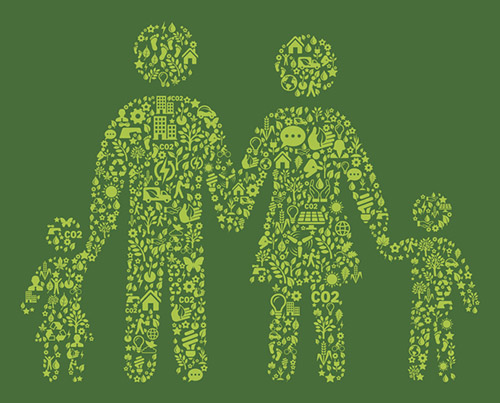Teaching your children to love the Earth and take better care of our planet starts at home. And it doesn’t take drastic—or costly—changes to be more green at home to make a huge impact on improving our environment.
As you strive to reduce your family’s carbon footprint, here are some easy—and budget-friendly—tips you can do with your kids to help make a positive difference in the world.
Conserve Your Water, You’re Likely Using a lot
There are several simple changes you can make to save water—and money! To be more green at home, observe how long you keep your faucets running in the bathroom and kitchen throughout the day. Most likely, a lot longer than you should. Regular showerheads have a flow rate of about five to seven gallons per minute. And running the water in your faucet for two minutes uses about six gallons of water. Here are some quick eco-friendly fixes:
- Turn off the faucet while brushing your teeth and washing your hands.
- Take shorter showers. Have fun with it. The family member with the shortest shower, pics the family movie of the week and the person with the longest shower has to do a designated dreaded chore.
- Wash your dishes by hand and turn off the faucet while scrubbing. If you have to use your dishwasher, only run when full.
Still using Paper and Plastic in the Kitchen?
Using paper plates, towels—and plastic utensils and cups—for daily family meals makes for a quick clean up, with less dish pile up in the sink. But when you do this, you’re not being green at home. Did you know that the fork you used for one meal can take up to 1,000 years to decompose? And over 73% of beach litter is plastic from bottles, grocery bags and food storage containers—which is hurting our environment and ocean animals. Also, paper really does kill trees, which we need more of because trees absorb carbon dioxide and slow the rate of global warming. Here’s what you can do to reduce your paper and plastic consumption:
- Use the reusable dinnerware, utensils and cups/glasses in your kitchen cabinets. If you use disposable cutlery, make sure it’s made of biodegradable or compostable material.
- Use cloth towels, instead of paper towels as much as you can. Have special rags ready for the occasional spill. It will save you money!
- Have each family member get one or two glass/stainless steel reusable water bottle. You can have your kids choose their favorite TV character or movie theme.
- Use reusable bags at the grocery store and other places you shop. And instead of throwing out your plastic grocery bags. Reuse them in your home as trash bags in small garbage cans), or take them with you when you go the store.
- Recycle any paper and plastic products (and cans) you use. You can also turn your plastic into a rainforest bottle!
Go Meatless at Least Once a Week
Being green at home includes your diet too! One of the quickest ways we can lower our collective greenhouse gas emissions is to eat less meat. Livestock are responsible for about 14.5% of global greenhouse gas emissions, according to the United Nations’ Food and Agriculture Organisation (FAO), which negatively affects global warming. Even cutting out some meat, especially red meat, will lower your family’s impact on the environment. Try these tips to make it happen:
- Get creative with breakfast with meatless options. Try this frittata!
- Skip meat (and cheese) one day a week with your family. You’d reduce emissions equivalent to taking your car off the road for five weeks, or reducing everyone’s daily showers by 3 minutes!
- Cook a new meatless meal together every week and keep 3-5 family favorites in your meal planning rotation. You can teach your kids about cooking, math and other life lessons along the way!
Be energy efficient, Turn off Your lights and unplug
Talk to your family about energy waste and how to adjust your daily behaviors. Do you leave lights and TVs on in rooms that you’ve left or overnight? Do you open the refrigerator and leave it open while you figure out what you need? Save money on your energy bill and help the environment by cutting back. To keep the family motivated, violators will have time deducted from their favorite screen activity. Here are some energy-saving tips:
- Turn off the lights and TV if you are going to be out of the room for more than 15 minutes. Create reminder notes with your kids and place them in the rooms you use the most. And power down laptops, video games, tablets and other devices when not in use.
- Unplug small appliances when they aren’t being used, like the blender you use to make smoothies or the toaster oven. It’s estimated that 75% of energy used to power household electronics is consumed when they are switched off (which costs you up to $200 a year!).
- Help your kids make it a habit to fully close the front and back doors—and refrigerator/freezer doors. Use a magnet on the refrigerator or a bell on the handle on doors to help family members remember.
Work together to be more green at home and you will fall into new habits that help our environment and you’ll also have more money in the bank from all of your savings!
Kisha DeSandies Lester is the senior editorial and digital manager at National PTA.





